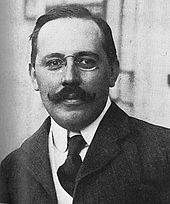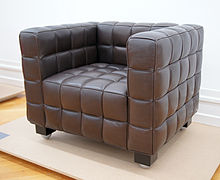Josef Hoffmann (architect)
Josef Franz Maria Hoffmann (born December 15, 1870 in Pirnitz , Moravia , Austria-Hungary ; † May 7, 1956 in Vienna ) was an Austrian architect and designer . With Koloman Moser he was a founding member and one of the main representatives of the Wiener Werkstätte .
Life
Josef Hoffmann came from a wealthy family, his family was involved in the princely Collalto 's calico factory and his father was mayor of Brtnice / Pirnitz in the Jihlava / Iglau district in Moravia. He was originally supposed to become a lawyer at the request of his father, but felt more drawn to technology, whereupon his understanding parents sent him to the State Trade School in Brno , from where he got excellent grades.
Afterwards he worked at the military building department in Würzburg , after which he studied at the Academy of Fine Arts in Vienna with Karl von Hasenauer and Otto Wagner . In Wagner's office he met Joseph Maria Olbrich , with whom he founded the Vienna Secession in 1897 , an artists' association which he left with Gustav Klimt and others in 1905 .
His early architectural work, based on simple cubic forms, had probably received his first inspiration in southern Italy, as he had been honored with the Prix de Rome of the Academy at the end of his architecture studies and lived in Italy for a year. Here, the cubic houses with their flat roofs and smooth facades had impressed him very much.

With the banker Fritz Wärndorfer and the painter Koloman Moser he founded the Wiener Werkstätte in 1903 , for which he designed many products. From 1899 he was a teacher at the Vienna School of Applied Arts . In the interwar period he also designed designs for Scheibbs' sound industry .
Hoffmann was a member of the Masonic Lodge "Die Treue".
In 1906 he built his first major plant, the sanatorium in Purkersdorf . Through contacts with Adolphe Stoclet , who sat on the supervisory board of the Austro-Belgian Railway Company , which operated the Aspang Railway in Austria , the Palais Stoclet with the Stoclet frieze designed by Gustav Klimt was created from 1905 to 1911 as the main work of art of the Viennese Secessionism in Brussels . The building has been a UNESCO World Heritage Site since the end of June 2009 . In 1907 Hoffmann was a co-founder of the German Werkbund , in 1912 of the Austrian Werkbund . 1913–1915, another major work was the Villa Skywa-Primavesi in Vienna 13., Gloriettegasse 18 .; In 1914 he built the Austrian House at the Cologne Werkbund exhibition .
As a result, his style became more and more sober, whereby he was increasingly limited to functional buildings. Hoffmann welcomed the "Anschluss" of Austria to Nazi Germany in 1938 , because he hoped the new regime would bring an economic upswing and the revival of his architectural practice.
Although he himself was defamed and marginalized as a “degenerate decorative artist” by the Nazi architectural ideologist Paul Schmitthenner , those in power of the time were interested in exploiting Hoffmann's fame as an instrument. Even though the resulting drafts did contain symbols of the dictatorship, he still did not follow the official Nazi aesthetic from an artistic point of view.
According to his plans, the embassy palace of the German embassy on Rennweg in Vienna was rebuilt from 1938 to 1945 and the building was used as a branch of the Foreign Office as well as the "House of the Wehrmacht" and officers' home. In 1957/1958 it was demolished due to severe bomb damage. A silver jug made according to Hoffmann's design in 1940/1942 is ornamented with oak leaves , swords and swastika .
After the Second World War , Hoffmann took on various official tasks, such as the Austrian General Commissioner at the Venice Biennale and membership in the Austrian Art Senate . In 1950 he founded the Federation of Modern Visual Artists of Austria together with Albert Paris Gütersloh .
Hoffmann was married twice. In 1903 he married Anna Hladik (* 1880) and had their son Wolfgang (1900–1969), who also became an architect. The marriage ended in divorce in 1922. In 1925 he married Carla (Karla) Schmatz (* 1894), who was previously a mannequin at the Wiener Werkstätte. As a widow, Carla Hoffmann entrusted Wittmann Möbelwerkstätten with the rights for her husband's designs. Wittmann began to reproduce Hoffmann furniture in the 1970s, including models such as Fledermaus , Purkersdorf , Haus Koller , Armlöffel and the famous Kubus . Hoffmann's lamp designs have been handcrafted by the Viennese company WOKA since the 1970s with a license from the Josef Hoffmann Foundation.
In 2007 the Austrian Post dedicated a special stamp to him, a detail from the necklace designed by Josef Hoffmann in 1916. The jewel is now in the holdings of the Museum of Applied Arts, MAK Vienna . In 1987 the MAK organized an exhibition about Josef Hoffmann entitled Josef Hoffmann: Ornament between Hope and Crime . After a MAK exhibition on Josef Hoffmann in 1992 in his birthplace in Brtnice / Pirnitz in the Czech Republic, contacts with the Moravian Gallery in Brno were intensified. Since 2006, both institutions have been running the building on an equal footing as the joint branch of the Josef Hoffmann Museum . The museum presents a permanent collection and also changing exhibitions on Josef Hoffmann and his contemporaries are organized. The MAK Vienna maintains a large collection of works by the Wiener Werkstätte and thus also by Josef Hoffmann. Some of Josef Hoffmann's works are publicly accessible online at the MAK Collection .
Hoffmann lived for a long time at Schleifmühlgasse 3 in the 4th district. In 1939 he moved to an apartment at Salesianergasse 33 in the 3rd district, near the Lower Belvedere. He died there on May 7, 1956. Two days later the social democratic Arbeiter-Zeitung wrote that the last living co-founder of the Vienna Secession had passed away; he revolutionized the Austrian arts and crafts as well as architecture . Hoffmann was still involved in the selection of Austrian works of art for this year's Venice Biennale a few weeks before his death . He headed the architecture class at the Academy of Applied Arts for almost four decades. His life's work has already gone down in the history of the art of our century .
The City of Vienna dedicated an honorary grave to him in the Vienna Central Cemetery (group 14 C, number 20). Fritz Wotruba created the tombstone .
In Purkersdorf the Josef-Hoffmann-Gasse is named after him.
Awards and honors
- 1950: Grand Austrian State Prize for Architecture
- 1951: Honorary doctorate from the Vienna University of Technology
- Honorary doctorate from the Technical University of Dresden
Exhibitions
- 1987: Josef Hoffmann. Ornament between hope and crime (MAK Vienna)
- 1992: The baroque Hoffmann (Hoffmann birthplace, Pirnitz)
- 1992: Josef Hoffmann Designs (New York)
- 2003: Josef Hoffmann and the Wiener Werkstätte ( Kunsthaus Zug , Zug)
- 2005: Josef Hoffmann: An incessant process (Hoffmann birthplace, Pirnitz)
- 2006: Josef Hoffmann - Carlo Scarpa: The sublime in architecture (Hoffmann's birthplace, Pirnitz)
- 2007: Josef Hoffmann - Adolf Loos: Ornament and Tradition (Hoffmann Birthplace, Pirnitz)
- 2008: Josef Hoffmann - Donald Judd: Hypothesis (Hoffmann birthplace, Pirnitz)
- 2009: Josef Hoffmann: Inspirations (Hoffmann birthplace, Pirnitz)
- 2010: Rewriting the Space: Dorit Margreiter / Josef Hoffmann (Hoffmann Birthplace, Pirnitz)
- 2010: Josef Hoffmann: An incessant process. Designs from Art Nouveau to Modernism (Balingen)
- 2011: Josef Hoffmann - Oswald Oberhuber: All design and design (Hoffmann birthplace, Pirnitz)
- 2011/2012: Pioneers of Modernism: Gustav Klimt / Josef Hoffmann, Belvedere Palace
- 2017: The architects' glass. Vienna 1900–1937, MAK Vienna
Work (selection)
buildings
| photo | Construction year | Surname | Location | description | Metadata |
|---|---|---|---|---|---|

|
1899 |
Landhaus Paul Wittgenstein sen. (Conversion and equipment) BDA-ID: 24327 Wikidata |
Hohenberg (Lower Austria) , Bergerhöhe 1 location |
|
|
|
|
1900 |
Forestry office of the Wittgenstein forest administration and residential buildings of the staff BDA-ID: 129862 Wikidata |
Hohenberg, Untere Hauptstrasse 4-6 location |
|
|
| 1900 | Carl Hochstetter tomb (now Resch / Reichel) |
Vienna 19, Grinzinger Friedhof , An den Lange Lüssen 33, Group 3 location |
Note: Group 3, grave 24. Name is not on the tombstone or overgrown. |
|
|

|
1900-1903 |
House Spitzer BDA-ID: 66136 Wikidata |
Vienna 19, Steinfeldgasse 4 location |
|
|

|
1900-1903 | Moser-Moll semi-detached house |
Vienna 19, Steinfeldgasse 6–8 Location |
Double house for Koloman Moser and Carl Moll in the artists' colony on Hohe Warte |
|
| 1900-1903 | House Dr. Henneberg |
Vienna 19, Wollergasse 8 location |
destroyed |
|
|
| 1902 | Establishment of the Wiener Werkstätte |
Vienna 7, Neustiftgasse 32 location |
Note: Metal sign on the portal. Showroom? |
|
|
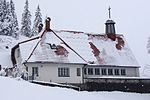
|
1902-1903 |
Evangelical Forest Church BDA-ID: 24949 Wikidata |
St. Aegyd am Neuwalde , Am Haselgraben 2 location |
|
|

|
1903 |
Union hotel of the "Poldihütte" Wikidata |
Josefa Hoffmanna 1533, Kladno, Czech Republic Location |
changed Note: Expanded to the side. Today hotel |
|
| 1903 | Landhaus Knips |
Seeboden am Millstätter See , Wirlsdorf 39 location |
Note: main building destroyed. Farm buildings preserved. |
|
|
| 1904 | Landhaus Dr. Wilhelm Figdor (conversion and furnishing) |
Baden (Lower Austria) , Weilburggasse 67 |
destroyed |
|
|

|
1904-1906 |
Sanatorium "Westend" BDA-ID: 42307 Wikidata |
Purkersdorf , Wiener Strasse 74 location |
Josef Hoffmann
|
|

|
1905-1906 | House for Beer-Hofmann |
Vienna 18, Hasenauerstraße 59 |
destroyed |
|
| 1905-1906 | House of Alexander Brauner |
Vienna 19, Gewygasse 11 |
destroyed |
|
|
| 1905-1906 | Hunting lodge Hochreith (conversion and furnishing) for Karl Wittgenstein |
Rohr im Gebirge , Tiefental 2 location |
|
||
| 1905-1907 | House Legler |
Vienna 19, Armbrustergasse 22 location |
Note: changed |
|
|
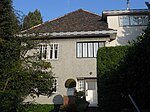
|
1906 | House Moll II |
Vienna 19, Wollergasse 10 location |
Note: 1928 extension |
|
| 1906-1907 | House of Helene Hochstetter |
Vienna 19, Steinfeldgasse 7 location |
destroyed |
|
|

|
1906-1911 |
Palais Stoclet Wikidata |
Avenue de Tervuren 281, Brussels Location |
Note: can be seen as the main architectural work of Hoffmann. |
Josef Hoffmann
|

|
1907 | "Fledermaus" cabaret facility |
Vienna 1, Kärntner Strasse 33 |
destroyed |
|

|
1908 |
Business portal of the kk Hof- und Staatsdruckerei BDA-ID: 9511 Wikidata |
Vienna 1, Seilerststätte 24 location |
Portal of the Kk Hof- und Staatsdruckerei Note: partially preserved |
|

|
1908 | Emil Zuckerkandl's tomb |
Vienna 19, Döblinger Friedhof, Hartäckerstraße 65, Israelite Department Location |
Note: Group i1 grave 1 |
|
| 1909 | Villa Pickler (conversion and furnishing) |
Trombitás út 19, Budapest, Hungary Location |
|
||
| 1909-1910 | Heinrich Böhler House (adaptation) |
Baden, Pelzgasse 11 location |
Note: original construction by H. Zimmermann in 1880 |
|
|

|
1909-1911 |
Eduard Ast House BDA-ID: 66137 Wikidata |
Vienna 19, Steinfeldgasse 2 / Wollergasse 12 location |
|
|
| 1910 | Country house Otto Böhler |
Kapfenberg , Mariazeller Straße 32 location |
Note: Either house number 28, 30 or destroyed |
|
|
| 1910-1911 | House Pazzani |
Klosterneuburg-Weidling , Wolfsgraben 66 location |
Note: also stated in the source as 1927 |
|
|
| 1910-1911 | Albert Figdor crypt |
Vienna 19, Döblinger Friedhof, Hartäckerstraße 65 Location |
Note: Group HA number 2 |
|
|

|
1911 | Gustav Mahler tomb |
Vienna 19, Grinzinger Friedhof, Group 6 location |
|
|
| 1911 | Austrian pavilion |
Art show, Rome, I |
destroyed |
|
|
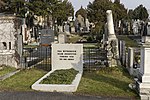
|
1912 | Tomb Paul Wittgenstein u. Helene Hochstetter |
Vienna 19, Grinzinger Friedhof, Group 9 location |
Note: Date of death 1928 |
|
| 1912-1913 | Villa Edmund Bernatzik |
Vienna 19, Springsiedelgasse 28 Location |
|
||

|
1912-1913 | Landhaus Koller (extension and conversion) |
Oberwaltersdorf , Pfarrgasse 15 location |
|
|
| 1912-1914 | Portal and management rooms of the steelworks "Poldihütte" |
Průmyslová 1343, Kladno, Czech Republic Location |
Note: At AZW: Vienna 3, Invalidenstrasse 5–7 |
|
|

|
1912-1914 |
House Botstiber-Hertzka BDA-ID: 41941 Wikidata |
Vienna 19, Kaasgrabengasse 30–32 location |
Note: Monument protection and Wikidata object separate |
|

|
1912-1914 |
House Drucker-Wellesz BDA-ID: 41943 Wikidata |
Vienna 19, Kaasgrabengasse 36–38 location |
Note: Monument protection and Wikidata object separate |
|

|
1912-1914 |
Sokolowski-Küpper House BDA-ID: 41986 Wikidata |
Vienna 19, Suttingergasse 12-14 location |
Note: Monument protection and Wikidata object separate |
|

|
1912-1914 |
House Vetter-Michel BDA-ID: 41988 Wikidata |
Vienna 19, Suttingergasse 16-18 location |
Note: Monument protection and Wikidata object separate |
|
| 1913 | Hospital of the Bosnian Electricity Company |
Jajce , Bosnia |
Note: Assumption of property at AVNOJ Museum, Jajce |
|
|

|
1913-1914 |
Villa and garden Skywa-Primavesi BDA-ID: 41571 Wikidata |
Vienna 13, Gloriettegasse 18 Location |
Josef Hoffmann
|
|
| 1913-1914 | Drawing material factory Pelikan Günther Wagner |
Vienna 10, Laxenburger Straße |
Note: only partially implemented. Exact address unclear. Destroyed? Data error? |
|
|
| 1914 | Otto Primavesi country house |
Winkelsdorf / Kouty nad Desnou 62, Loučná nad Desnou, Czech Republic Location |
changed Note: Today hotel. Expanded in the same style |
|
|
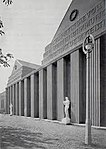
|
1914 | Austrian pavilion |
Cologne Werkbund exhibition , Cologne |
destroyed |
|
| 1914-1917 | Wacker chemical plants |
Burghausen , Germany location |
|
||
| 1918 | Villa Franz Hatlanek |
J. Hory 1801, Kladno location |
|
||

|
1919 | Tomb of the Knips family |
Vienna 13, Hietzinger Friedhof , Group 32 location |
|
|
| 1919 | Edmund Bernatzik's crypt |
Vienna 19, Heiligenstädter Friedhof, group TUL 16 location |
|
||
| 1919-1922 | Sigmund Berl House |
Husova 913/2, Freudenthal / Bruntál , Czech Republic Location |
|
||
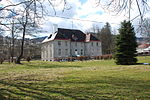
|
1920-1921 |
Fritz Grohmann House Wikidata |
Würbenthal / Vrbno pod Pradědem , Czech Republic Location |
Josef Hoffmann
|
|
| 1920 | Elisabeth Sanatorium (renovation) |
Lázeňská 323, Velké Losiny, Czech Republic Location |
Note: Hotel today |
|
|
| 1922-1923 | House of Ing. Dunckel |
Tapolesany ut 3, Budapest location |
|
||
| 1923 | Eduard Ast's crypt |
Vienna 19, Heiligenstädter Friedhof location |
Note: TUR 17 |
|
|

|
1923-1924 |
House Sonja Knips BDA-ID: 41964 Wikidata |
Vienna 19, Nusswaldgasse 22 location |
|
|

|
1923-1926 |
Landhaus Ast BDA-ID: 13075 Wikidata |
Auen-Waldpromenade 35 / Süduferstraße 35, Auen, Schiefling am Wörthersee , Austria location |
Note: 1934 also increased by Hoffmann; Address according to the source "Auen, Golfstraße 21" |
|
| 1924 |
Villa Gretl |
Gars am Kamp , Weisergasse 179 location |
Note: House number 16 in the source incorrect |
|
|

|
1924-1925 |
Klose-Hof BDA-ID: 52514 Wikidata |
Vienna 19, Philippovichgasse 1 location |
|
|

|
1924-1925 |
Winarsky-Hof BDA-ID: 42005 Wikidata |
Vienna 20, Stromstrasse 36–38 location |
Note: Stairs 1–14, 26, 27, with Behrens, Frank, Strnad and Wlach |
|
| 1924-1931 | Workers' housing company Grohmann |
Husova 306, 307, 335, 413, 305. Palackého 262, 327, 337, 339, 343, Sadová 351, Kopečná 305, 412. Vrbno pod Radedem, Czech location |
Note: Coordinates refer to Palackého 337 |
|
|
| 1925 | Austrian pavilion |
Arts and Crafts Exhibition Paris |
destroyed |
|
|
| 1928-1929 | Isidor Diamant house |
Strada Ion Creangă 2–4, Cluj-Napoca, Romania Location |
|
||
| 1928-1929 | Office building of Industria Sarmei SA |
Strada Iuliu Maniu 25, Cluj-Napoca, Romania Location |
Note: with Oswald Haerdtl |
|
|

|
1928-1932 |
Anton-Hölzl-Hof BDA-ID: 84650 Wikidata |
Vienna 10, Laxenburger Strasse 94 location |
Note: with Max Fellerer |
|
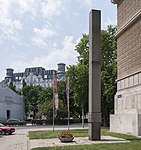
|
1929-1930 | Monument to Otto Wagner |
Vienna 1, Makartgasse 2 location |
|
|
| 1930 | Villa Lothar Grohmann |
Jesenická 347/33, Vrbno pod Pradědem location |
|
||

|
1932 |
Altmann & Kühne business premises BDA-ID: 89400 Wikidata |
Vienna 1, Graben 30 location |
Altmann & Kühne business premises Note: with Oswald Haerdtl |
|

|
1932 | Four row houses |
Werkbundsiedlung , Vienna 13, Veitingergasse 79–85 Location |
Note: Monument protection separated |
|
| 1934 | Villa Sinaiberger (aka Serger) |
Skoczów , Poland, Katowickiej 9 location |
Note: something changed. Inconsistent. Address information may be incorrect in various sources. |
|
|

|
1934 | Austrian Pavilion ( White Cube ) in the Biennale in Venice |
Venice, Italy location |
|
|

|
1937-1939 |
Establishment of the Schroll publishing and printing house Wikidata |
Vienna 5, Arbeitergasse 1–7 / Spengergasse location |
Note: later Christoph Reisser's sons |
|
| 1939-1940 | "House of the Wehrmacht" (conversion of the former German embassy) |
Vienna 3, Metternichgasse 3 location |
destroyed Note: with Josef Kalbac |
|
|
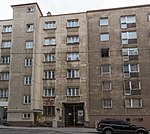
|
1949-1950 |
Residential complex Blechturmgasse 23-27 BDA-ID: 6426 Wikidata |
Vienna 4, Blechturmgasse 23–27 Location |
Note: with Josef Kalbac |
|

|
1951 |
Housing complex Silbergasse 2-4 BDA-ID: 9512 Wikidata |
Vienna 19, Silbergasse 2-4 location |
Note: with Josef Kalbac |
|

|
1953-1954 |
Residential complex Heiligenstädter Straße 129 BDA-ID: 128806 Wikidata |
Vienna 19, Heiligenstädter Straße 129 Location |
Note: with Josef Kalbac |
|
Interior design / design
- 1897–1903: Participation in almost all exhibitions of the Vienna Secession in Vienna 1, Friedrichstrasse 12
- 1898: “Viribus unitis” room at the Kaiser anniversary exhibition in Vienna, Rotunda grounds
- 1899: Business premises of the Apollo candle factory in Vienna 1., Am Hof 3 (not preserved)
- 1899: Furnishing for Max Kurzweil in Vienna 4, Schwindgasse 19
- 1900: Exhibition rooms of the Vienna School of Applied Arts and the Secession at the Paris World Exhibition in 1900 in Paris, Champ de Mars
- 1901: Furnishing for Helene Hochstätter in Vienna
- 1902: Furnishing for Dr. Hans Salzer in Vienna 6, Gumpendorfer Strasse 8
- 1902: Furnishing for Baroness Mautner Markhof in Vienna 3, Landstraßer Hauptstrasse 138
- 1902: Furniture for Fritz Wärndorfer in Vienna 18, Weimarer Strasse 59
- 1902: Rooms of the Vienna Secession and the Vienna School of Applied Arts at the Rhenish-Westphalian Industrial and Commercial Exhibition in Düsseldorf
- 1903: Establishment of the Wiener Werkstätte in Vienna 7, Neustiftgasse 32
- 1904: Exhibition rooms of the Secession at the World Exhibition St. Louis 1904 in St. Louis (Louisiana, USA)
- 1904: Fashion salon for Emilie Flöge in Vienna 6, Mariahilfer Straße 1c
- 1904: Participation in the arts and crafts exhibition in Berlin
- 1905: Furnishing for Margarethe Stonborough-Wittgenstein in Berlin , In den Zelten 215
- 1906: Furnishing for Dr. Hermann Wittgenstein in Vienna 3, Salesianergasse 7
- 1907: Wiener Werkstätte sales office in Vienna 1., Graben 15 (not preserved)
- 1907: Exhibition rooms for Gustav Klimt and the Wiener Werkstätte at the International Art and Horticultural Exhibition in Mannheim
- 1907: Establishment of the Fledermaus Cabaret in Vienna 1, Kärntner Strasse 33
- 1908: Exhibition rooms of the Wiener Werkstätte at the Kunstschau Wien 1908 in Vienna, on the site of today's Wiener Konzerthaus
- 1908: Entrance building and overall planning of the "Kunstschau" in Vienna 3. Heumarkt (not preserved)
- 1909: Austrian area at the 10th International Art Exhibition in Munich
- 1910–1914: Participation in various exhibitions at the Museum for Art and Industry in Vienna, Stubenring 3
- 1911: Garden of the Stoclet Palace in Brussels
- 1911: Participation in the art exhibition in Rome
- 1912: Graben coffee house in Vienna 1., Graben 29a (reconstruction 1928, not preserved)
- 1912: Interior fittings and furniture in the Gallia apartment in Vienna 4, Wohllebengasse 4.
- 1913: Austrian department at the art exhibition in Dresden
- 1916–1917: Furnishing for Paul Wittgenstein senior. in Vienna 8, Friedrich Schmidt-Platz 6
- 1917: Exhibition design in Stockholm
- 1917–1918: Wiener Werkstätte business premises in Vienna 1., Kärntner Straße 32 (not preserved)
- 1920: Participation in the 1920 art show in Vienna
- 1922–1924: Business portal and establishment of the art dealer Nebehay in Vienna 1., Kärntner Ring 7 (not preserved)
- 1923: Participation in the architecture exhibition at the Vienna School of Applied Arts
- 1927: Participation in the 1927 art show in Vienna
- 1927: Model apartment “Vienna and the Viennese” in Vienna
- 1929: Interior design of Villa Arpád Lengyel in Podtatranského 3, Pressburg
- 1930: Exhibition of the Austrian Werkbund in Vienna
- 1934: Anniversary exhibition of the Kunstgewerbeverein in Vienna
- 1934: Hall of Applied Arts at the Austria Exhibition in London
- 1934: Exhibition “The Liberated Crafts” in the Austrian Museum for Art and Industry in Vienna, Stubenring 3
- 1937: Participation in the Paris World Exhibition 1937 , Champ de Mars
- 1937: Interior design for the casino in Baden
- 1937–1939: Establishment of the Schroll publishing and printing house in Vienna 5, Arbeitergasse 1–7 / Spengergasse
- 1938: "House of Fashion" in the Lobkowitz Palace in Vienna 1, Lobkowitzplatz 2
- 1940–1941: business premises of the Meissen porcelain factory in Vienna 1., Kärntner Ring 14 (not preserved)
as well as other home furnishings, exhibition designs, furnishings for shops and bars, book and magazine illustrations; numerous designs for furniture (e.g. seven-ball chair), wallpaper, lamps, ornaments, jewelry, etc.
Trivia
A brooch designed by Josef Hoffmann for the Wiener Werkstätte in 1908 was knocked down in 2015 by the Viennese auction house “ Im Kinsky ” for € 529,200.
literature
- Eduard F. Sekler : Hoffmann, Josef. In: New German Biography (NDB). Volume 9, Duncker & Humblot, Berlin 1972, ISBN 3-428-00190-7 , pp. 429-431 ( digitized version ).
- Armand Weiser : Master of Architecture (Josef Hoffmann). Geneva 1930
- Gertrud Pott: The reflection of secessionism in the Austrian theater . Published by the Institute for Theater Studies at the University of Vienna. Verlag Wilhelm Braumüller, Vienna / Stuttgart, 1975
- Peter Gorsen : Josef Hoffmann. On the modernity of a conservative builder. In: Alfred Pfabigan (Ed.): Ornament and asceticism. C. Brandstätter, Vienna 1985, pp. 69-92.
- Eduard F. Sekler: Josef Hoffmann. The architectural work. Monograph and catalog raisonné. Residence, Salzburg / Vienna 1986, ISBN 3-7017-0306-X .
- Lillian Langseth-Christensen : A Design For Living. Viking, New York 1987, ISBN 0-670-80089-9 , (the author was a student at Hoffmann in Vienna from 1922 to 1925).
- Peter Noever , Oswald Oberhuber (ed.): Josef Hoffmann. Ornament between hope and crime. Austrian Museum of Applied Arts / University of Applied Arts (exhibition catalog), Residence, Salzburg / Vienna 1987, ISBN 3-900688-01-X .
- Peter Noever (ed.): The price of beauty. 100 Years of the Wiener Werkstätte [... appears on the occasion of the exhibition The Price of Beauty - For the 100th birthday of the Wiener Werkstätte. MAK Vienna, December 10, 2003 - March 7, 2004] Hatje Cantz, Ostfildern-Ruit 2003, ISBN 3-7757-1410-3 .
- Gabriele Fahr-Becker: Wiener Werkstätte. 1903-1932. Taschen-Verlag, Cologne 1994, ISBN 3-8228-2550-6 .
- Christian Witt-Dörring (Ed.): Josef Hoffmann. Interiors, 1902-1913. Prestel-Verlag, Munich 2006, ISBN 978-3-7913-3710-4 .
- Walter Zednicek: Josef Hoffmann and the Wiener Werkstätte. Zednicek, Vienna 2006, ISBN 978-3-9500360-8-4 (multilingual, mostly illustrations).
- August Sarnitz: Josef Hoffmann. In the universe of beauty. Taschen-Verlag, Cologne 2007, ISBN 978-3-8228-5588-1 .
- Agnes Husslein-Arco , Alfred Weidinger (ed.): Gustav Klimt - Josef Hoffmann. Modern pioneers. Prestel, Munich 2011, ISBN 978-3-7913-5148-3 .
- Michael Huey: Viennese silver. Modernes Design 1780-1918 , exhibition catalog Neue Galerie New York / Kunsthistorisches Museum Wien, Hatje Cantz, Ostfildern 2003. ISBN 978-3-7757-1317-7 .
Web links
- Literature by and about Josef Hoffmann in the catalog of the German National Library
- Entry on Josef Hoffmann in the Austria Forum (in the AEIOU Austria Lexicon )
- Entry on Josef Hofmann in the database of the state's memory for the history of the state of Lower Austria ( Museum Niederösterreich )
- Josef Hoffmann and the Wiener Werkstaette Video: 1991, WOKA Video, screenplay and director Wolfgang Karolinsky, 40 min
Individual evidence
- ↑ a b Thomas Chorherr : Great Austrians. Publishing house Carl Ueberreuter.
- ↑ Peter Jessen: German Form in the War Year, The Exhibition Cologne 1914 . In: Deutscher Werkbund (Hrsg.): Yearbook of the German Werkbund . tape 1915 . F.Bruckmamm A.-G., Munich 1915, p. 9 .
- ^ Eduard F. Sekler: Josef Hoffmann. The architectural work. Monograph and catalog raisonné. Residence, Salzburg / Vienna 1982, ISBN 3-7017-0306-X , p. 219
- ^ Eduard F. Sekler: Josef Hoffmann. The architectural work. Monograph and catalog raisonné. Residence, Salzburg / Vienna 1982, ISBN 3-7017-0306-X , p. 220.
- ^ Museum of Applied Arts, Vienna , inv. No. Go 1.864, cit. based on: Felicitas Heimann-Jelinek (Red.): Jewish Museum Vienna. Adolf Holzhausen's successor, Vienna [1996], ISBN 3-901398-03-1 , p. 96.
- ↑ Entry in the architectural dictionary
- ↑ August Sarnitz: Josef Hoffmann 1870-1956 In the universe of beauty. Taschen-Verlag, p. 93.
- ↑ site Woka Lamps Vienna
- ^ Austrian Post AG. Postage stamps: Art Nouveau - Josef Hoffmann
- ^ Josef-Hoffmann-Museum , homepage of the Moravian Gallery (English).
- ↑ MAK Collection online
- ↑ ed .: Architect Josef Hoffmann died , in: Tageszeitung Arbeiter-Zeitung , Vienna, No. 108, May 9, 1956, p. 5
- ^ Catalog for the Belvedere exhibition Cubism - Constructivism - Form Art. Vienna 2016, p. 91.
- ↑ TU Wien: Honorary doctorates ( memento of the original from February 21, 2016 in the Internet Archive ) Info: The archive link was inserted automatically and has not yet been checked. Please check the original and archive link according to the instructions and then remove this notice. . Retrieved March 26, 2015.
- ^ Directory of honorary doctoral candidates at the TH / TU Dresden
- ^ Josef Hoffmann's Volkswohnhaus restored town hall correspondence of July 26, 2005, accessed on June 11, 2010
- ↑ Anette Freytag : The garden of the Palais Stoclet in Brussels. Josef Hoffmann's “chef d'œuvre inconnu” . In: Die Gartenkunst 20 (1/2008), pp. 1–46.
- ↑ The auction house's advertisement in the daily newspaper Der Standard . Vienna, July 4, 2015, supplement album , p. A7.
| personal data | |
|---|---|
| SURNAME | Hoffmann, Josef |
| ALTERNATIVE NAMES | Hoffmann, Josef Franz Maria (full name) |
| BRIEF DESCRIPTION | Austrian architect and designer |
| DATE OF BIRTH | December 15, 1870 |
| PLACE OF BIRTH | Pirnitz , Moravia |
| DATE OF DEATH | May 7, 1956 |
| Place of death | Vienna |
